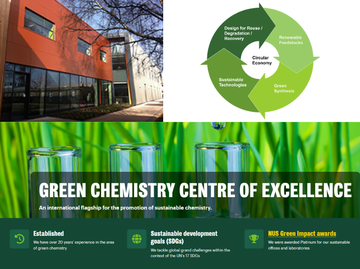Cambridge SCHEMA researcher visits Buchard Group in York
Dr Jirui Zhang, a SCHEMA postdoctoral research associate based at the University of Cambridge and working with SCHEMA Chemistry & Process Engineering Lead Prof Laura Torrente-Murciano, recently undertook a five-day research visit to the SCHEMA team based at the University of York’s Green Chemistry Centre of Excellence (GCCE).

Green Chemistry Centre of Excellence

Drs Nag, Zhang, and Prof Buchard

York
Flow chemistry is a synthetic chemistry tool where the continuous processing of reagents through pumps and tubular reactors is transforming how many synthetic problems are approached. Compared with conventional batch methods, continuous flow offers finer control over mixing, heat transfer, easier real-time monitoring, improved safety, better scalability and generally more reproducible outcomes. These attributes make flow chemistry attractive for rapid optimisation and for integrating reaction engineering with chemical design.
Bringing flow into polymer production is attractive but challenging. As polymers increase in molecular weight their viscosity can increase rapidly, and many polymerisations demand precise temperature control, features that can complicate continuous operation. However, recent work shows that continuous-flow polymerisations can deliver very well-defined polymers and faster process development when the engineering and kinetics are addressed together.
The scale of the current polymer markets underscores the need for greener, more circular approaches: global production and consumption of commodity polymers runs into the tens of millions of tonnes per year, motivating efforts to replace fossil-feedstock routes with bio-derived chemistries and improved manufacturing strategies. SCHEMA brings chemists, process engineers and digital technologists together to tackle exactly these sorts of supply-chain and sustainability challenges.
The aim of Jirui’s project is to accelerate the development of new sustainable materials and chemistries in the Hub by developing a modular platform to provide intrinsic kinetic and mechanistic understanding of polymerisation chemistries as well as developing the fundamental engineering principles for the development of tailored manufacturing routes. Keen to learn more about the wider Hub’s synthetic approaches and to explore how they could be integrated into her flow chemistry systems, Jirui was eager to visit Prof Antoine Buchard (SCHEMA’s Digital & Information Technologies Lead) and Dr Aniruddha Nag (SCHEMA PDRA) in York. She was interested in the Buchard group’s pioneering work in bio-derived polymers with targeted properties.

Catalysis and Process Integration group

Prof Laura Torrente-Murciano

University of Cambridge
Jirui’s goal was to further understand how the synthetic methods used in the Buchard group could be adapted to develop a modular platform for polymerisation processes, crucially the kinetic studies of polymerisation to address the key challenges in adapting for continuous flow synthesis. We caught up with Jirui after her visit and asked her a few questions …
How will you apply what you learned to your work – how is it relevant to your research?
The visit provided me with insights into the ring-opening copolymerisation (ROCOP) in batch systems. I had the opportunity to take part in hands-on demonstrations of the polymerisation of sugar-based materials, including solution preparation, sample characterisations, instrument facility introductions, etc. This experience helped me understand how these synthetic techniques could be translated from batch to flow systems. I also gained new perspectives on functionalised sugar-based materials, including their post-functionalisation, which I plan to incorporate directly into my flow synthesis research. This new knowledge will support my kinetic studies and inform the design and development of a modular polymerisation platform, ultimately enhancing my understanding of the ROCOP techniques and addressing the key challenges in my flow chemistry work.
Explain the importance of such lab visits for researchers. Would you encourage other researchers to do the same?
I would encourage every researcher to seek out these kinds of opportunities. These experiences promote professional growth, spark interdisciplinary collaboration, and accelerate scientific progress through the exchange of expertise. It also builds a network of real collaborative relationships and elevates research. Science is a conversation, and a laboratory visit is one of the most impactful ways to have a deep, meaningful collaboration.
Was it your first time at the University of York?
Yes, it was my first time visiting the University of York, and it made a great impression. The Green Chemistry Centre of Excellence (GCCE) is a facility with world-class capabilities, set on a beautiful campus, and the team was welcoming and supportive. It was also a wonderful surprise to reconnect with a former colleague from my PhD studies at the University of Warwick. I'm deeply grateful to Prof Antoine Buchard and Dr Aniruddha Nag for their hospitality throughout my visit.
Dr Aniruddha Nag says of the visit: “I trust Jirui got a better understanding of our processes here at York, and that she can implement them in the flow system at her lab in Cambridge. We are now in regular contact, and I will be running more experiments in the background and sending her data”.
“One of the strengths of the SCHEMA Hub is its multi-institutional and interdisciplinary nature. I commend Jirui for making the effort to visit in person and step outside her comfort zone to expand her expertise, and the York team for being such generous hosts. I strongly encourage everyone in SCHEMA - and across science more broadly - to embrace collaboration as both a way to share expertise and to grow through learning from others” - SCHEMA Hub Operations and EDI Manager, Dr Steph Montanaro



